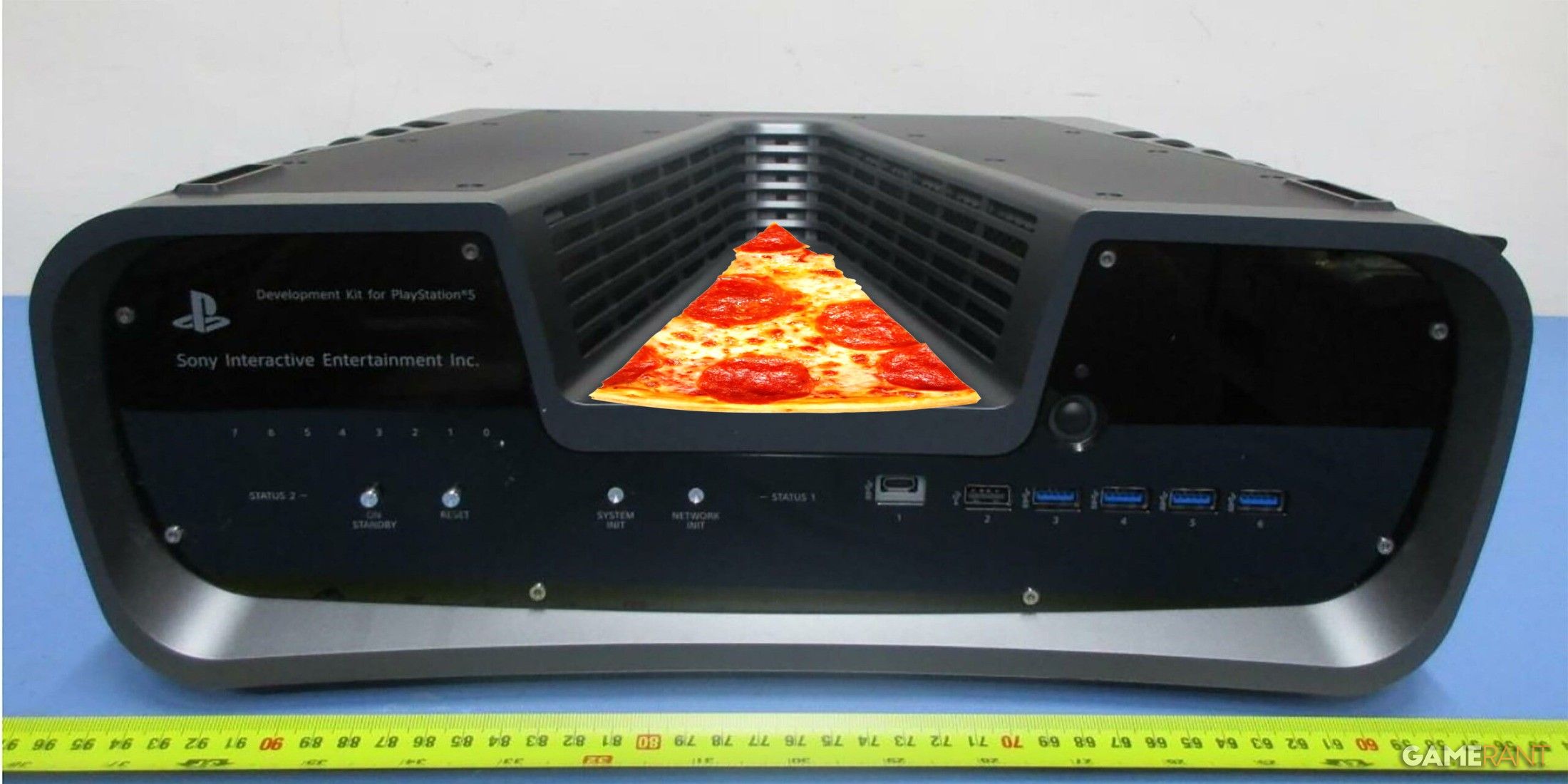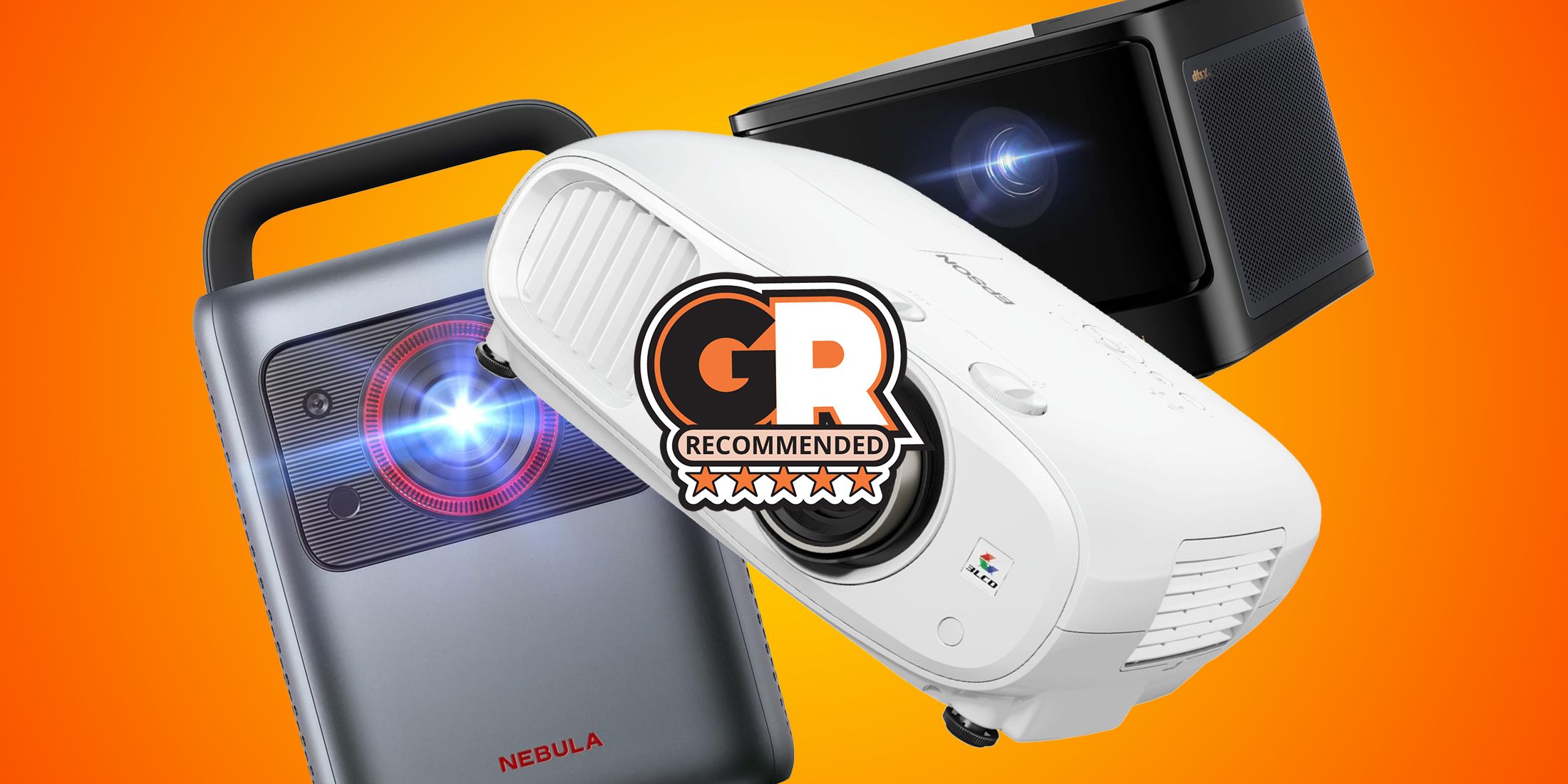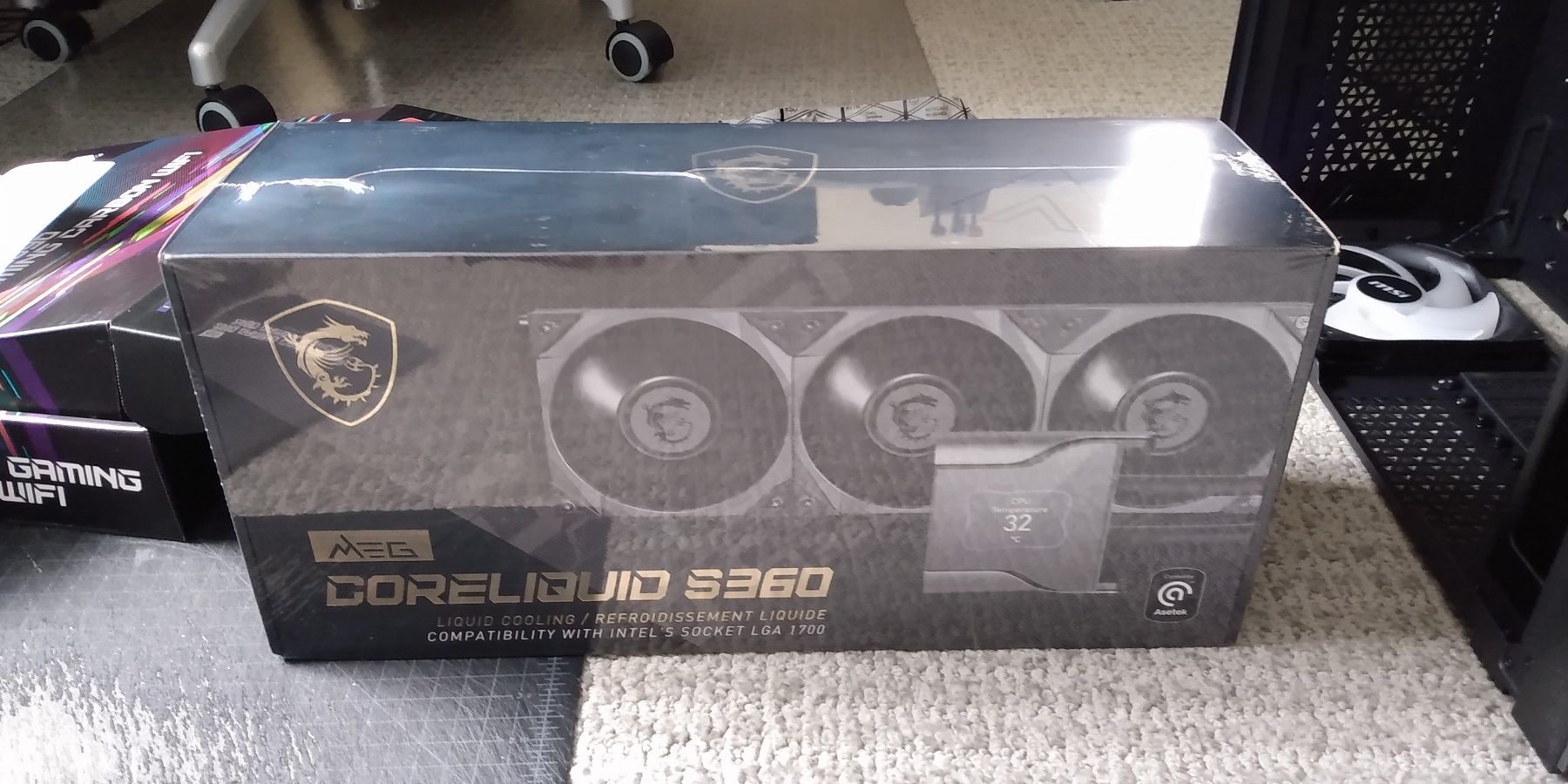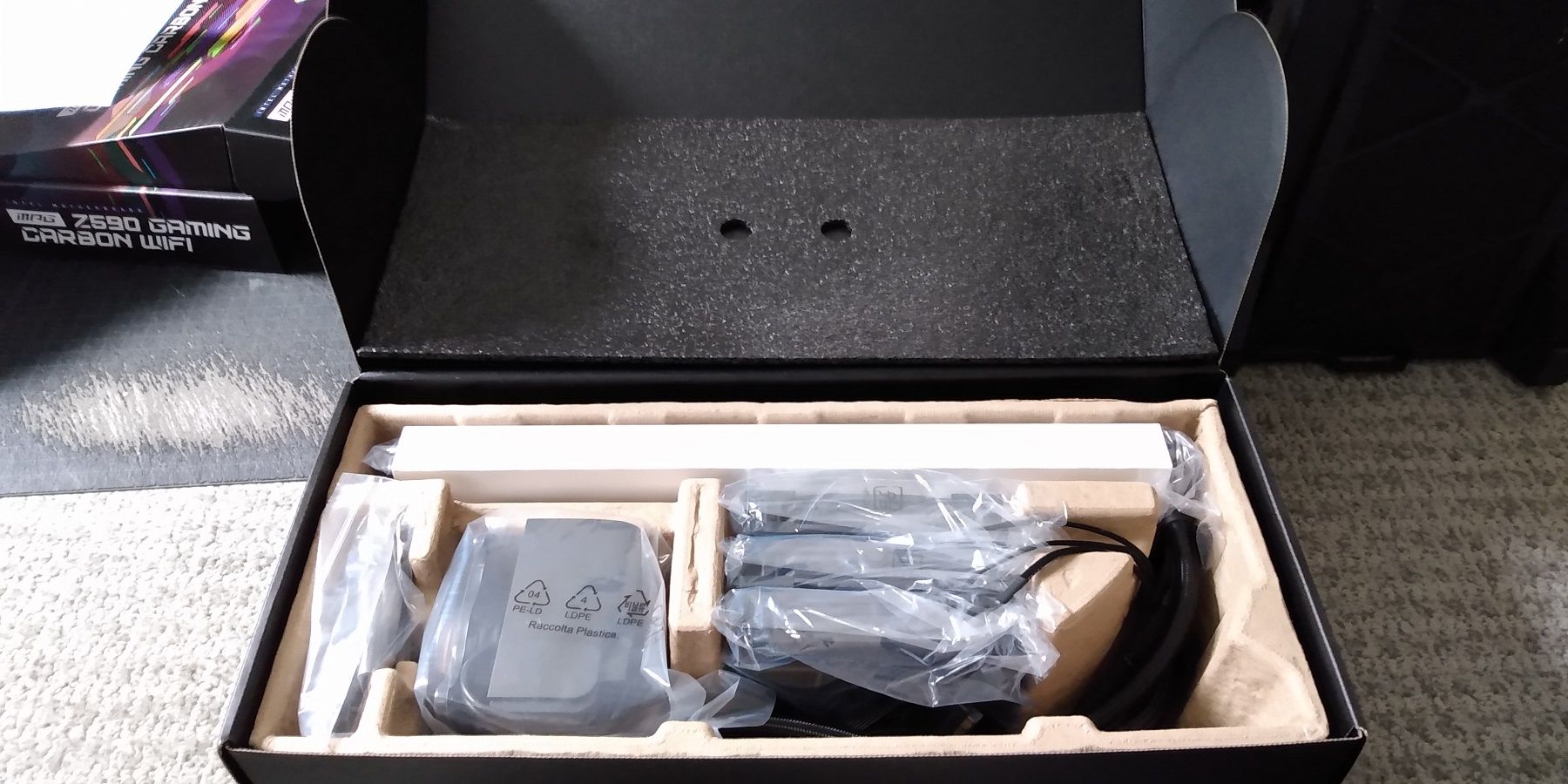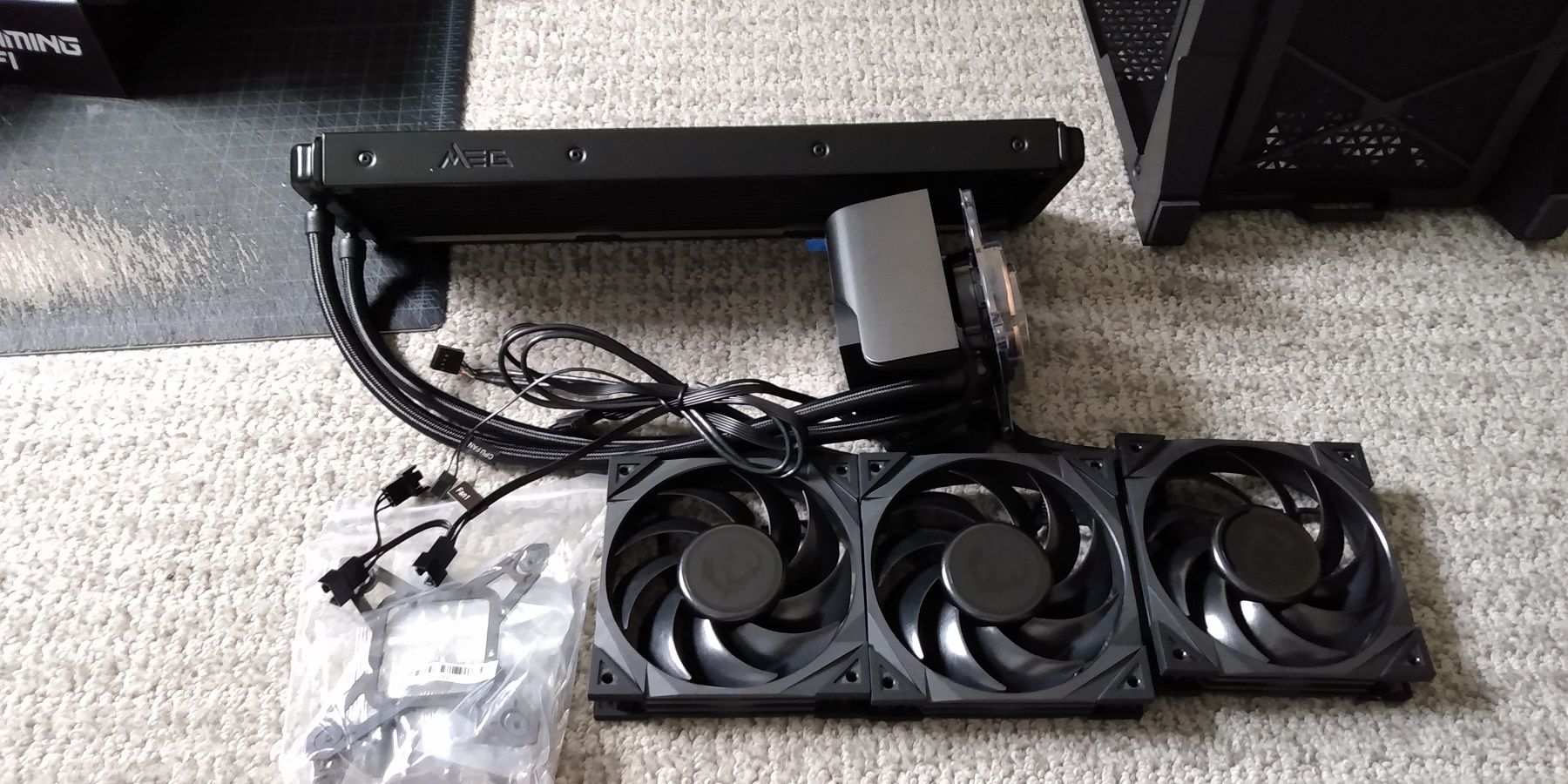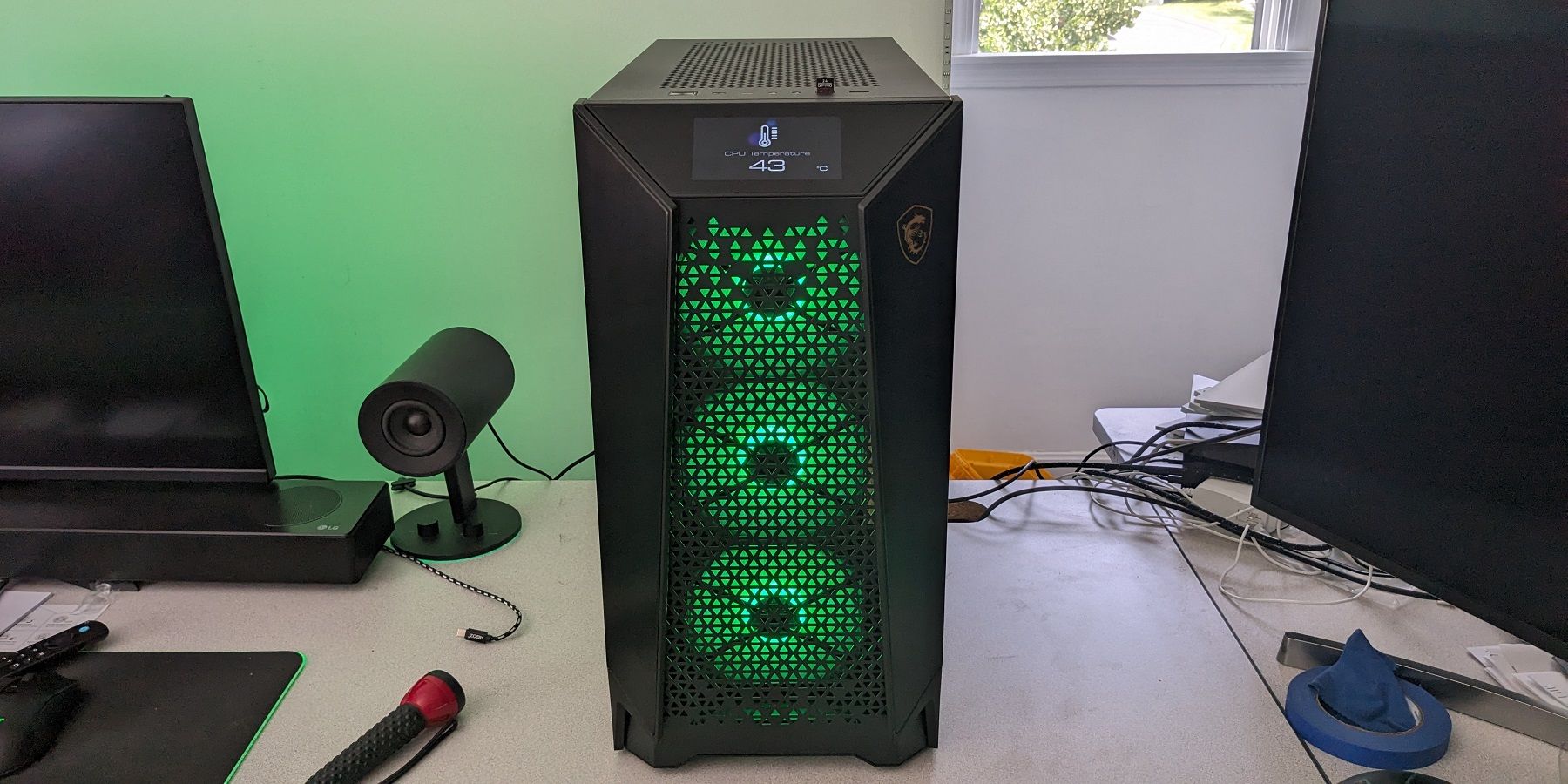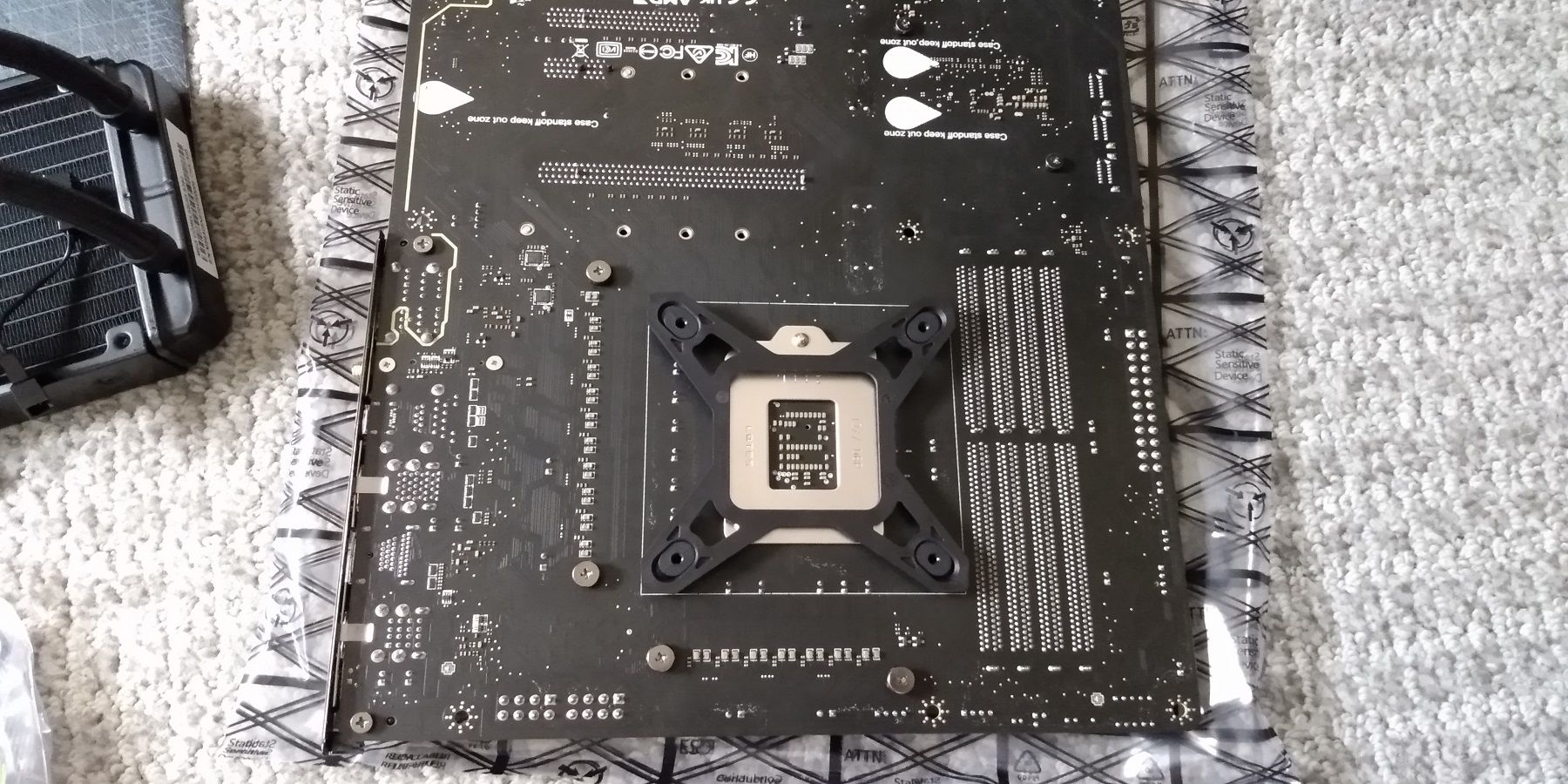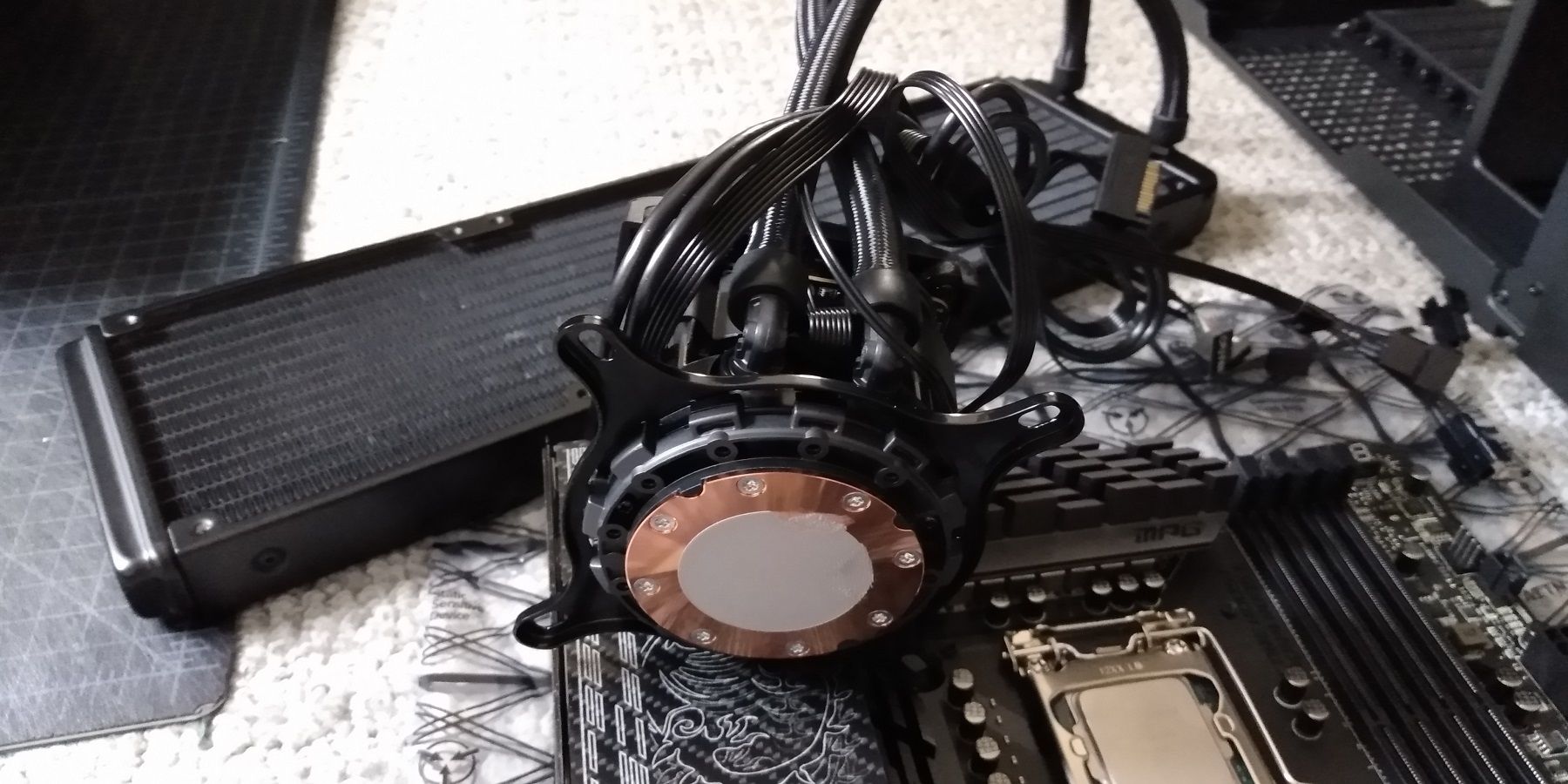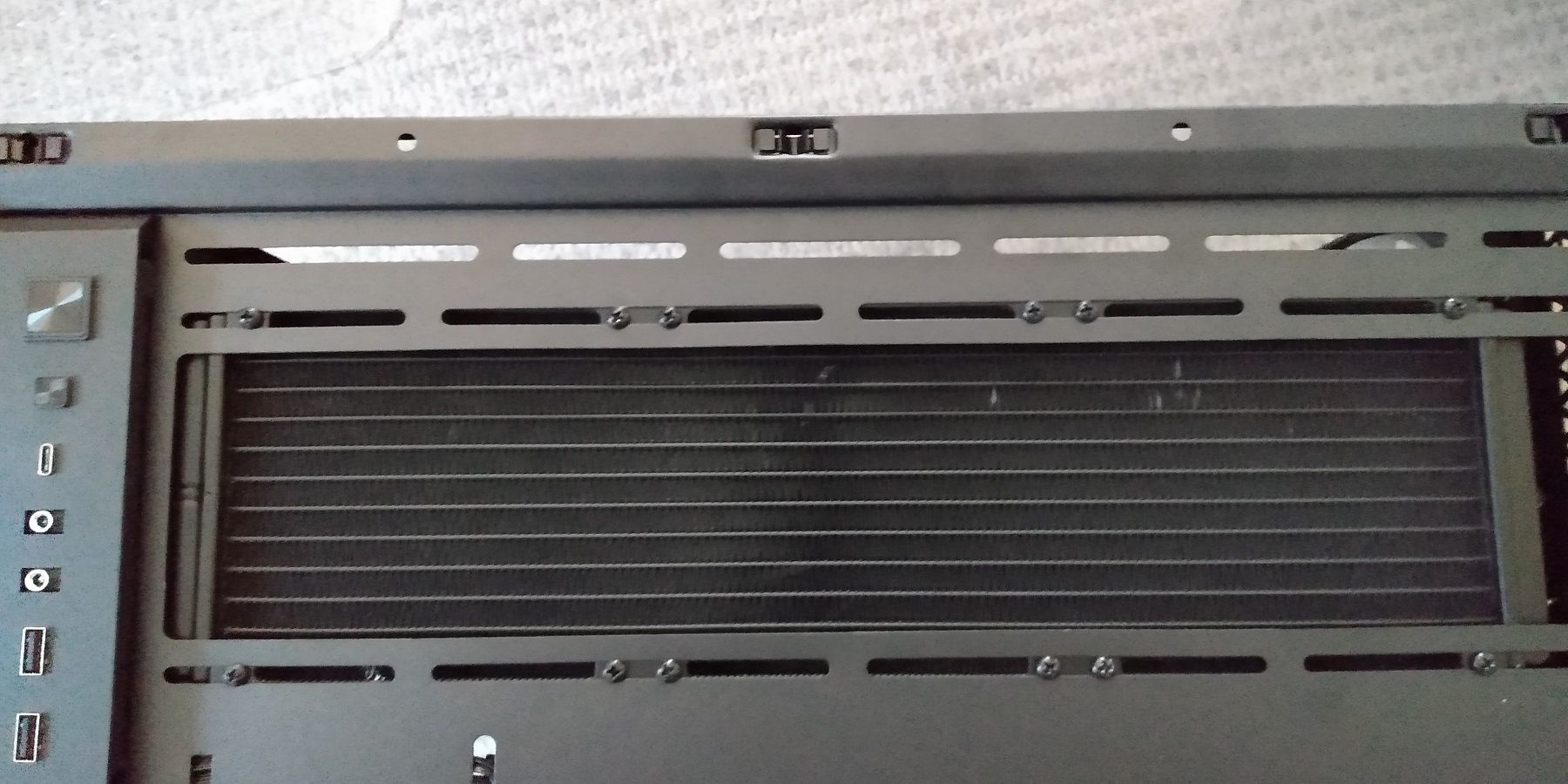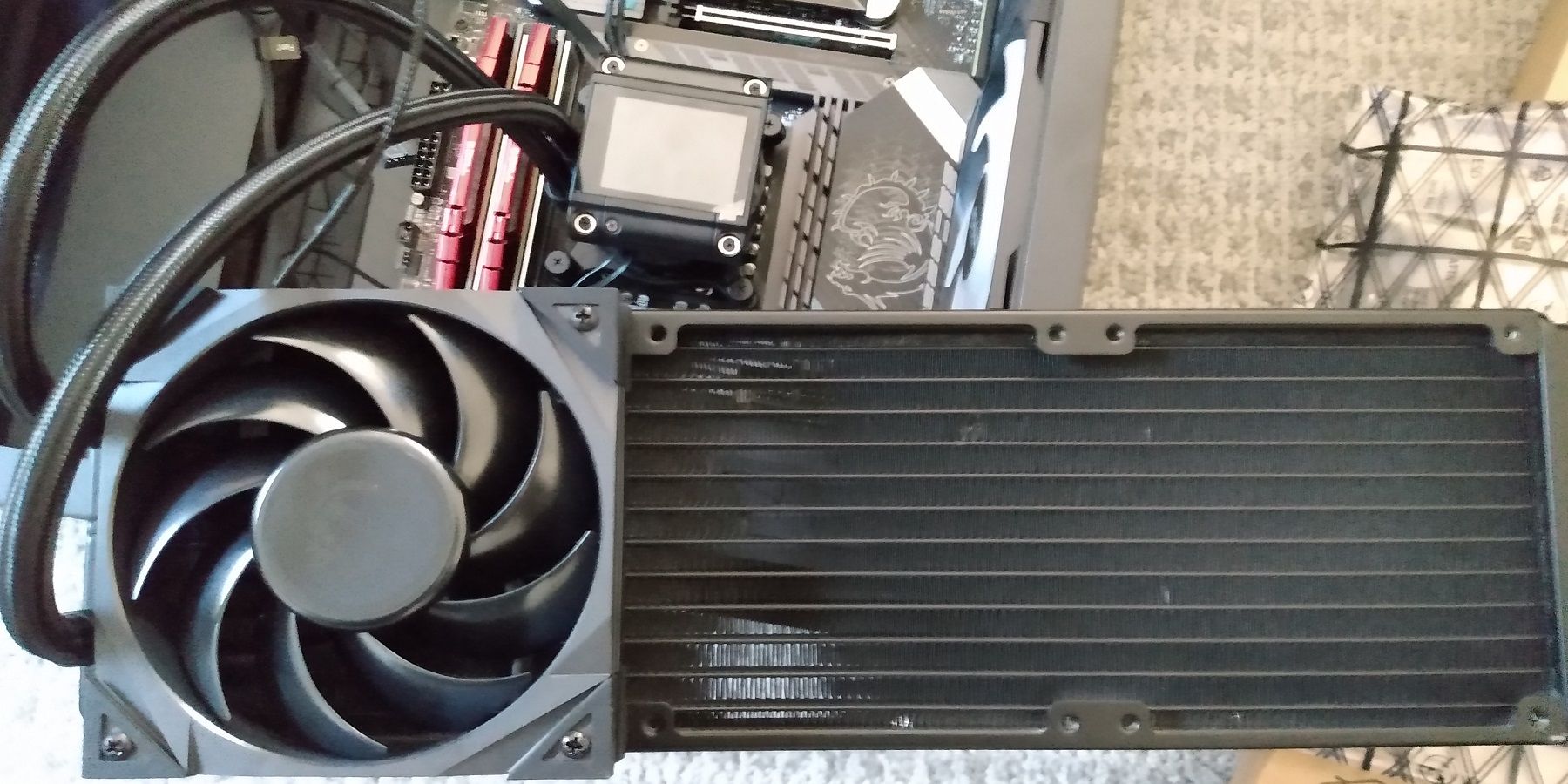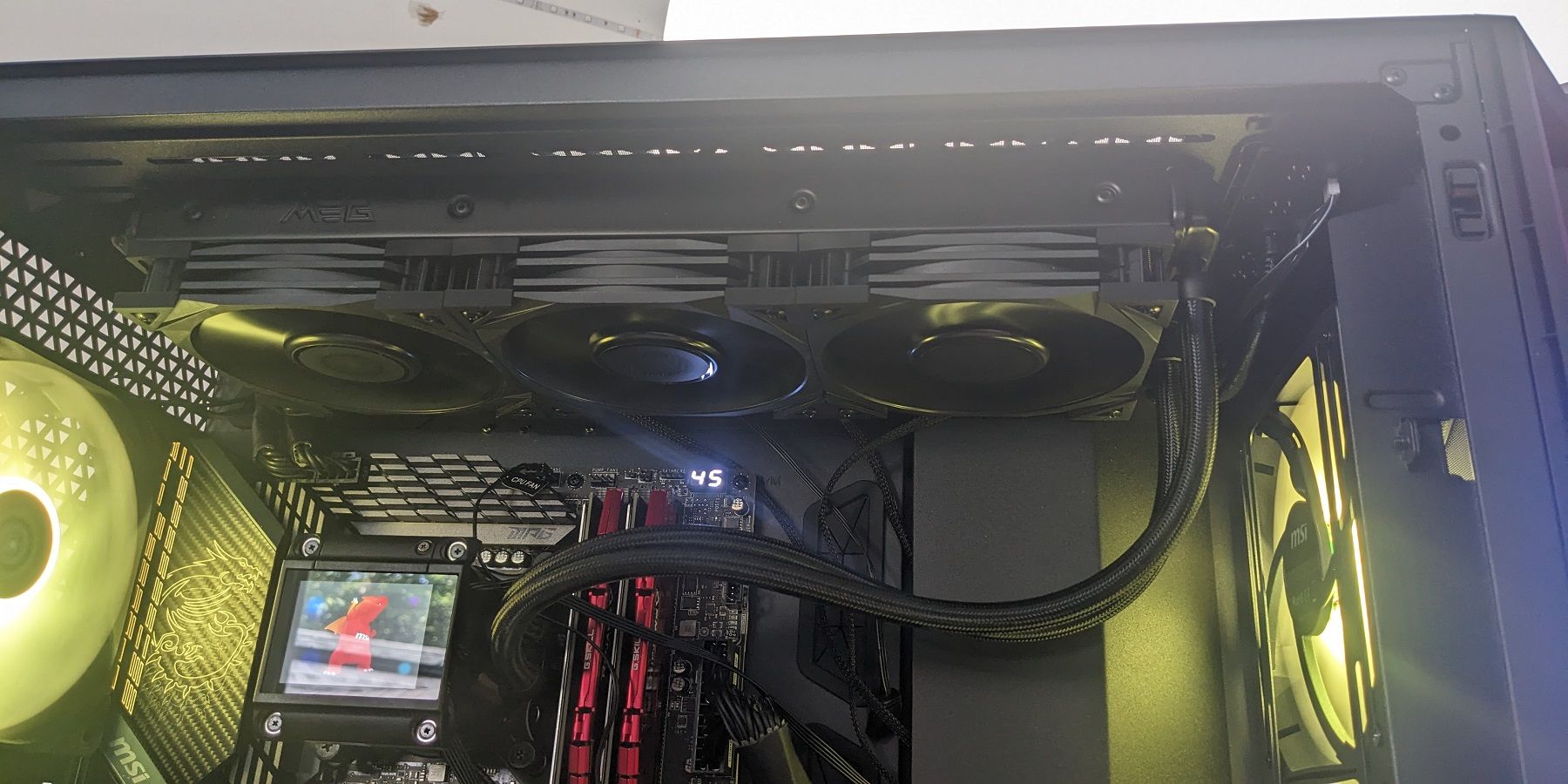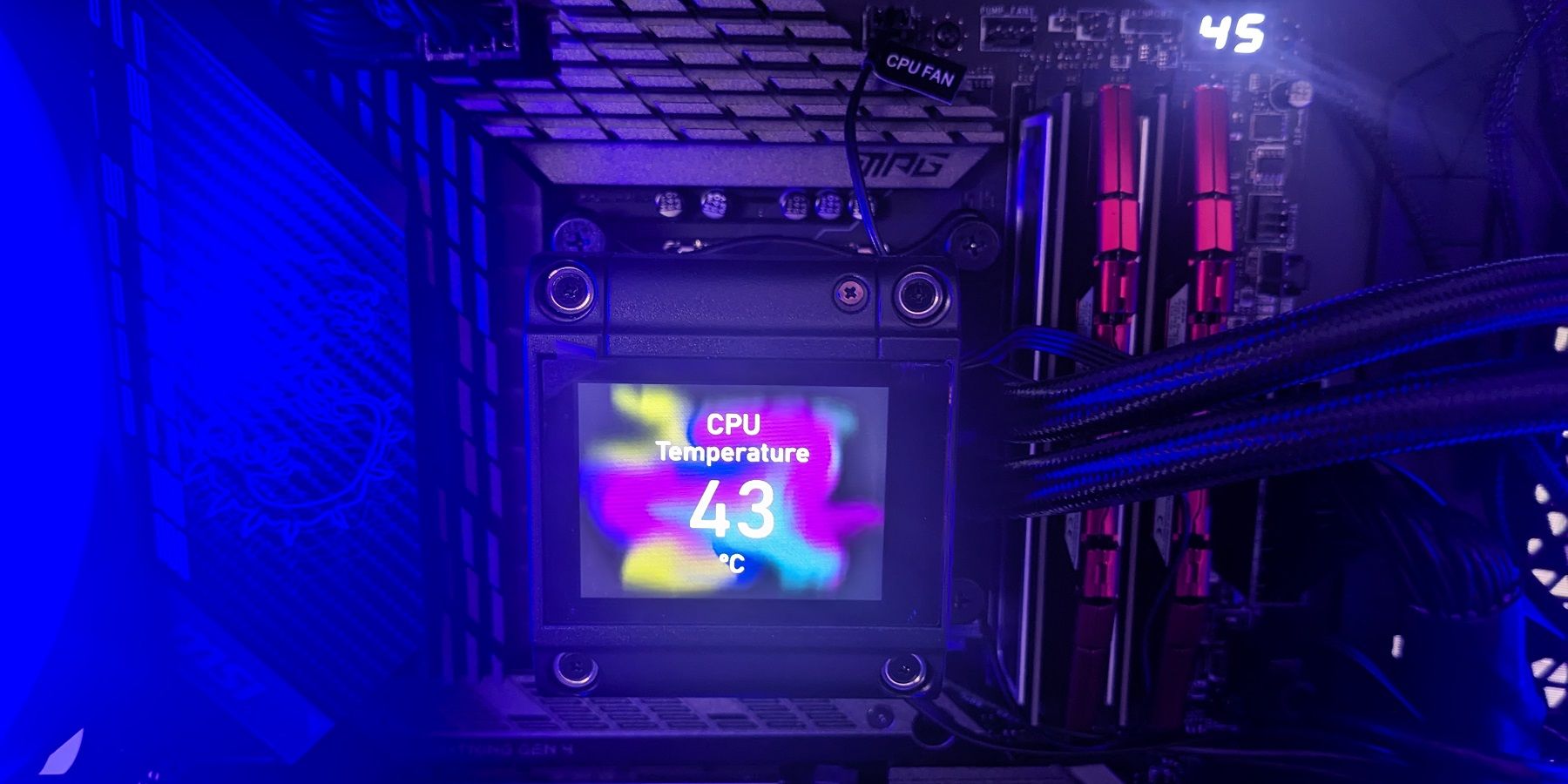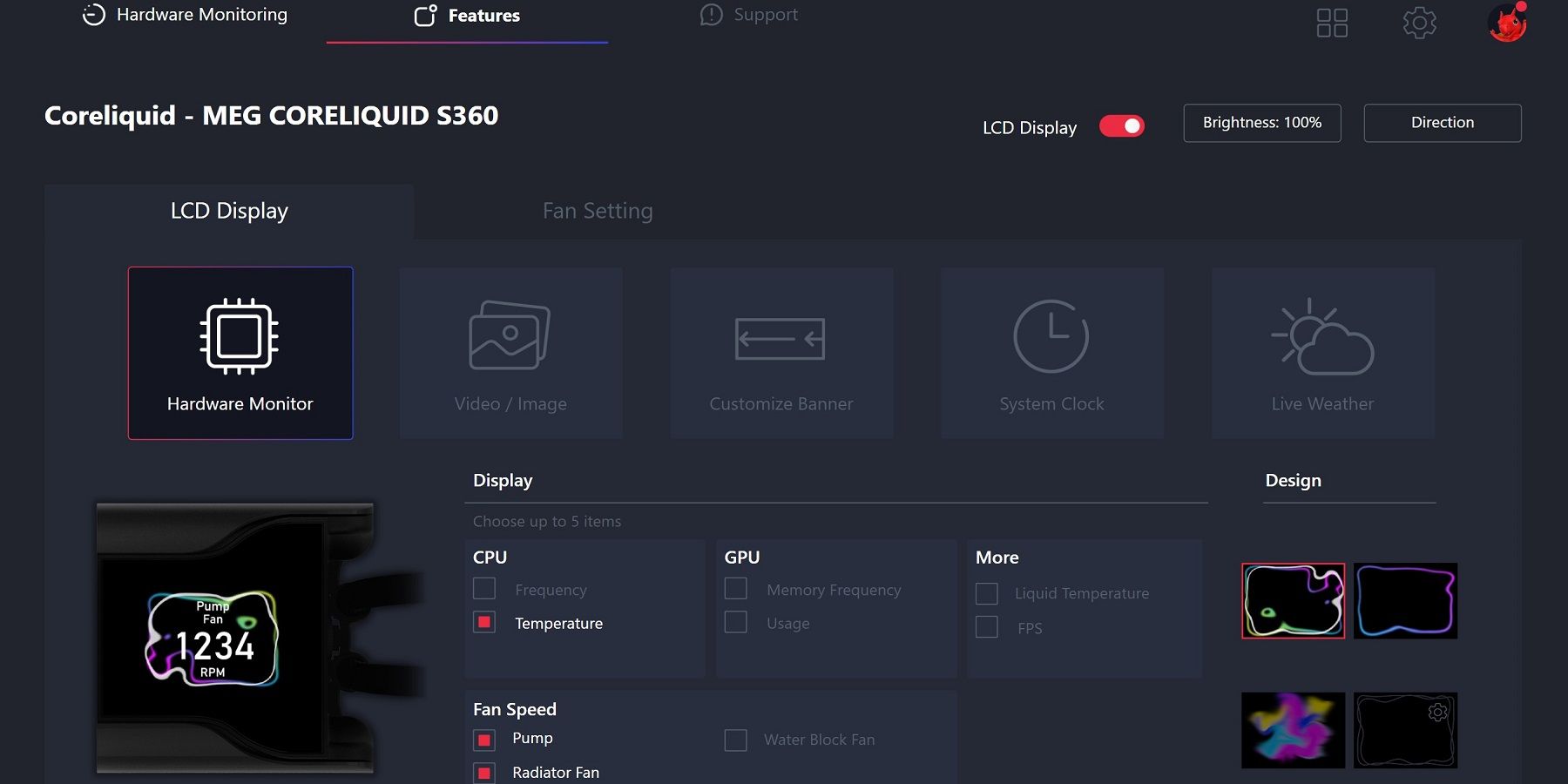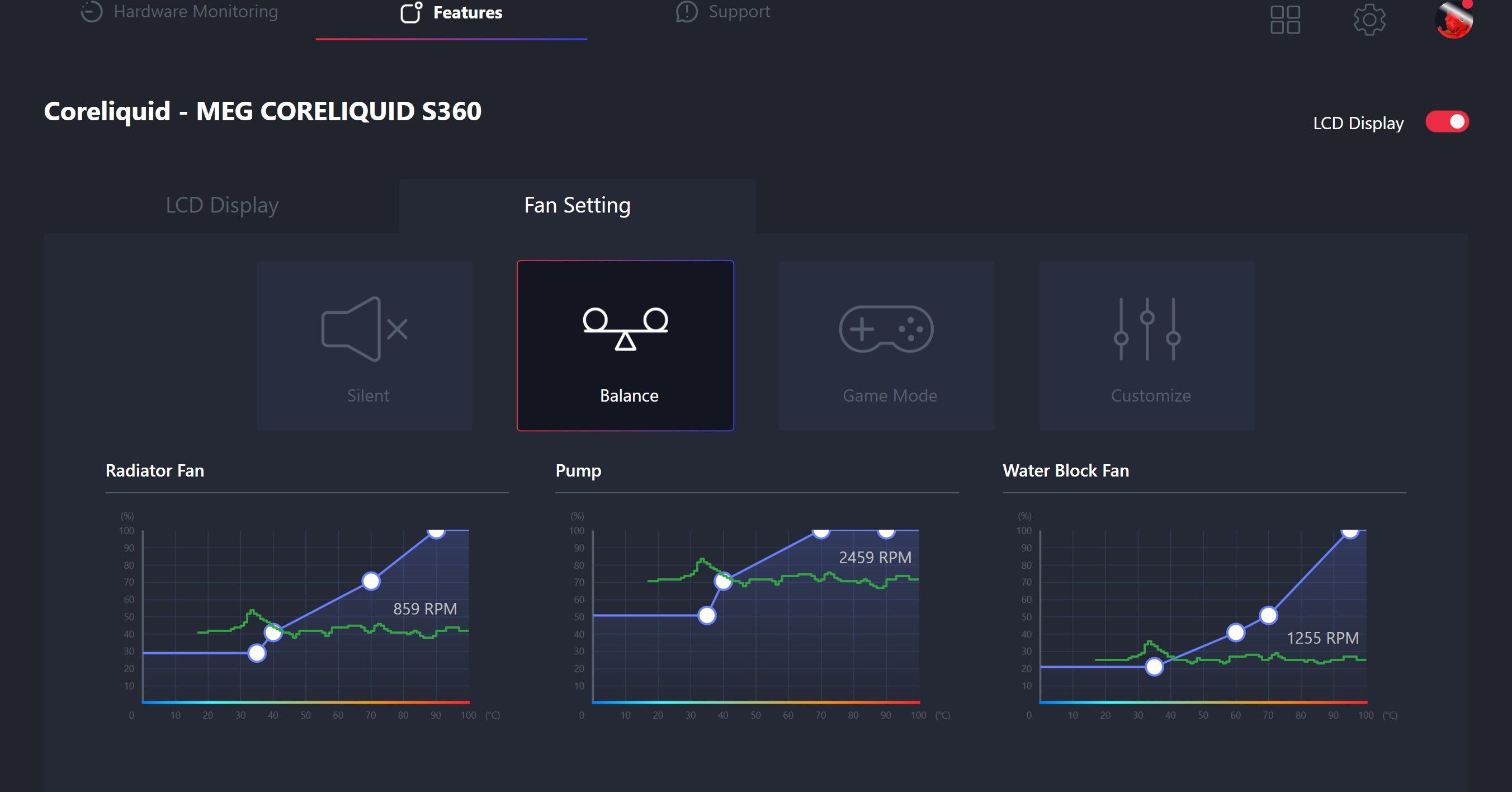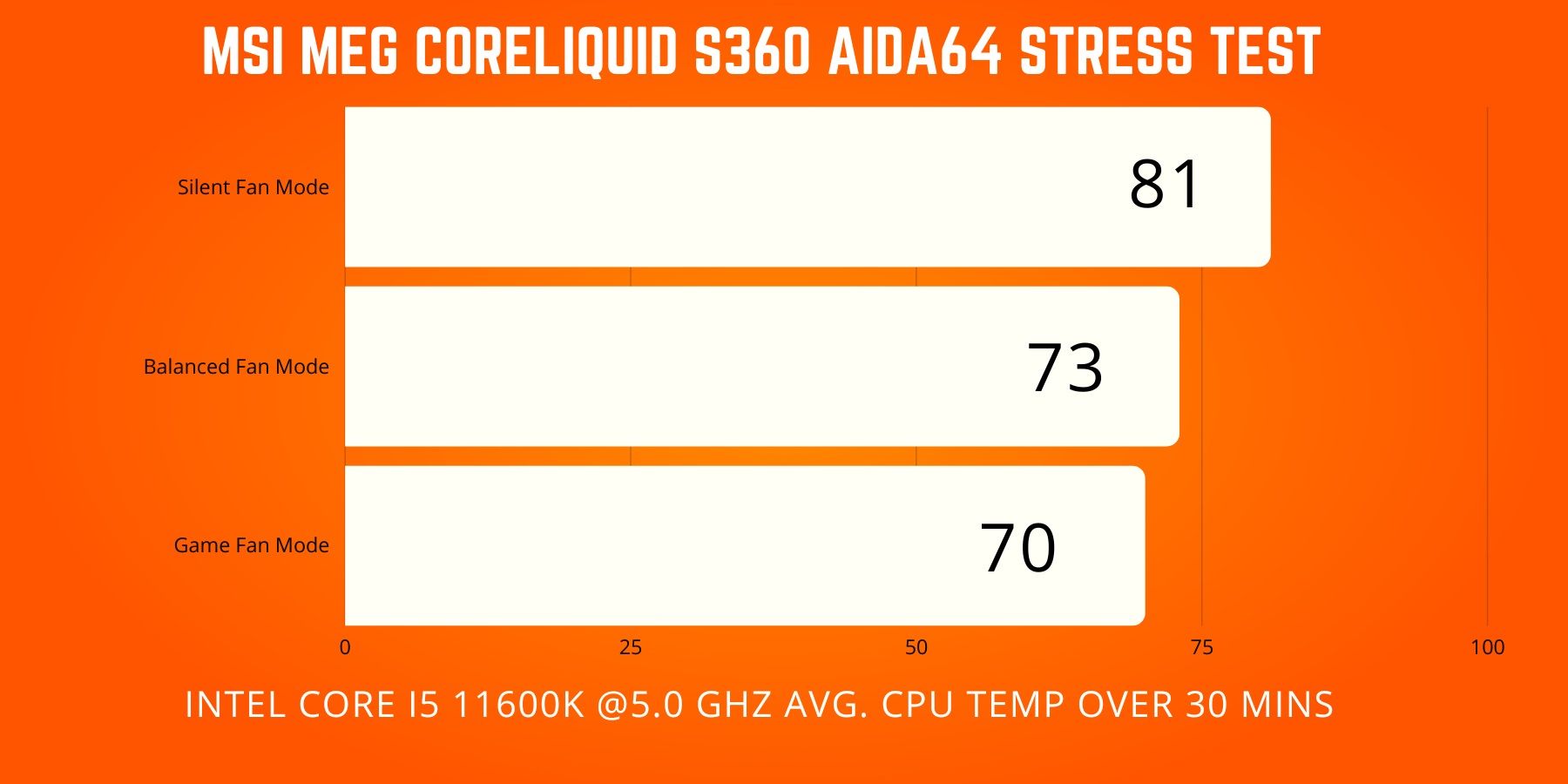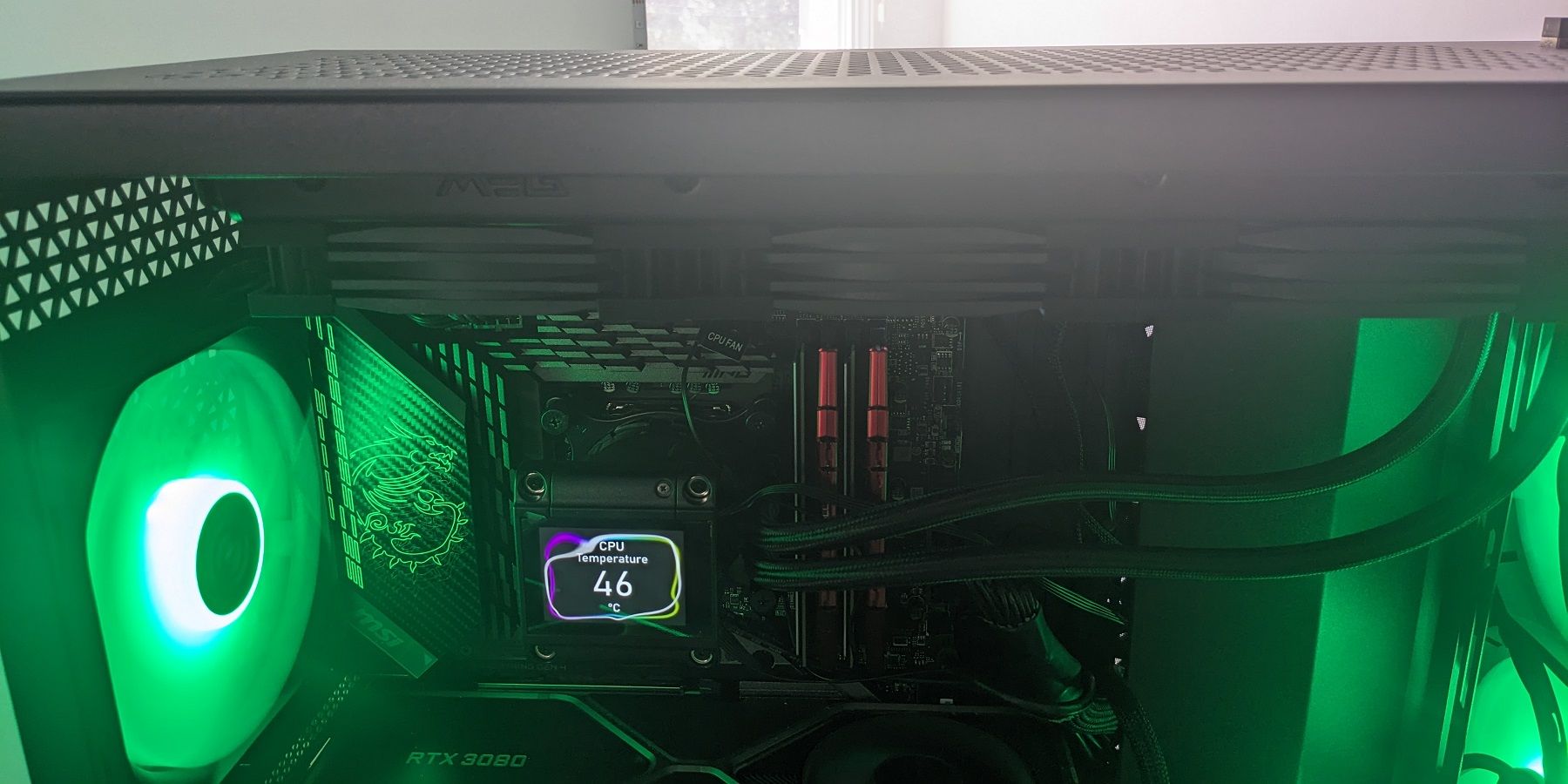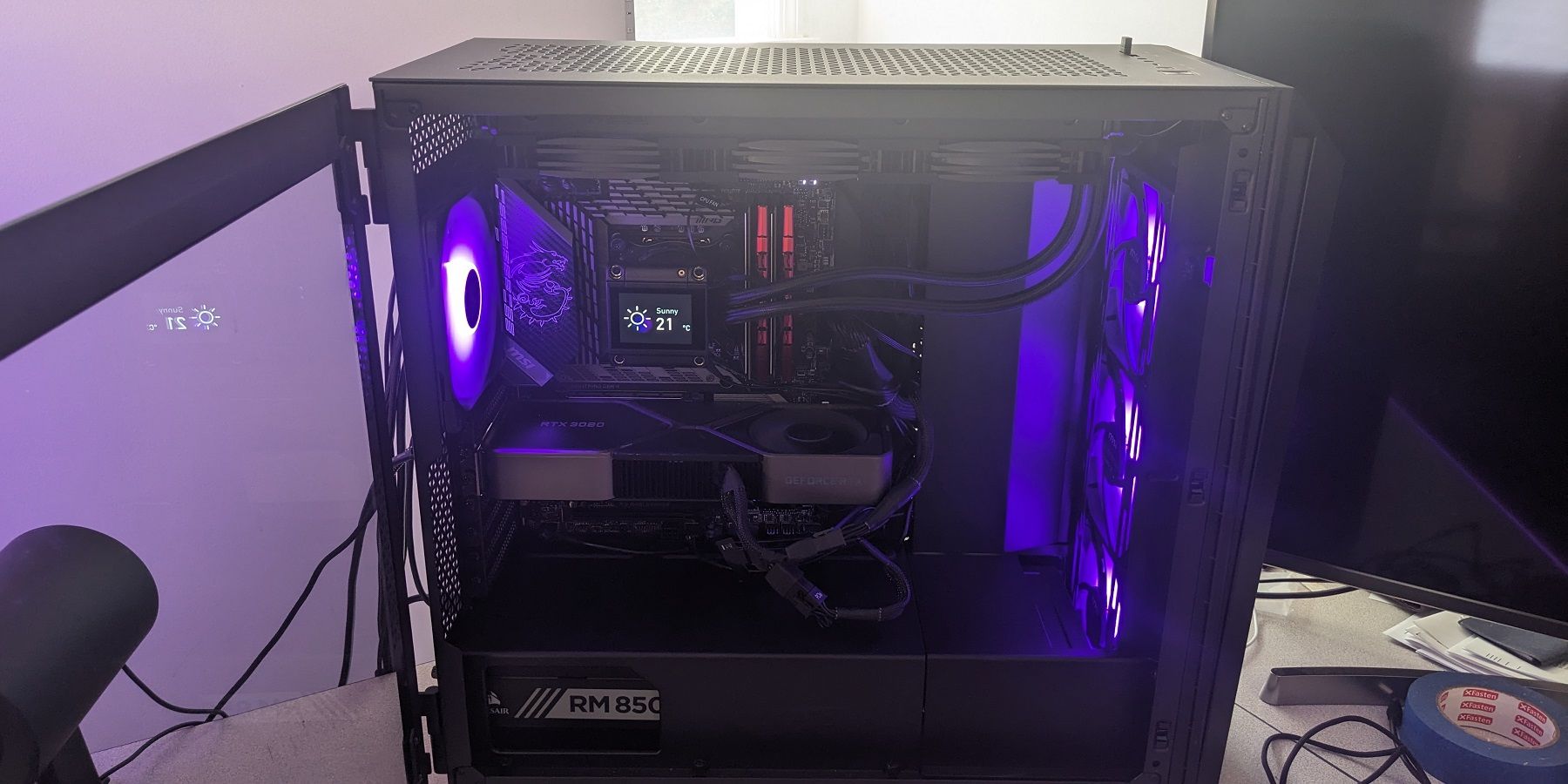Quick Links
Overclockers are a special breed of PC enthusiasts who look to squeeze out every bit of performance from their rigs. While some of these risk-takers overclock just for the thrill of it, the majority of them are trying to maximize framerates during gaming. Powerful graphics cards have the most influence on gaming performance, but certain titles like Microsoft Flight Simulator also heavily tax CPUs.
The MSI MEG CoreLiquid S360 is able to cool CPUs by continuously sending cool liquid through tubing back and forth from the processor to a radiator and fans which dissipate heat. Air coolers and heatsinks are adequate when running processors at stock settings, but AIO liquid coolers are often the best option for managing the temperatures of overclocked CPUs. Previously, water cooling was mostly a DIY endeavor, but more recently manufacturers like MSI have popularized easier-to-install closed-loop units.
With a 2.4-inch IPS LCD, the MEG CoreLiquid S360 aims to make the most modern-looking PC rigs even more cutting-edge. This AIO liquid cooler isn't all about appearances though with a 60 mm VRM fan in its water block and 3 efficient and quiet 120 mm Silent Gale P12 fans. Recently, Game ZXC tested out the capabilities of the MEG CoreLiquid S360 to see if its performance was enough to warrant its considerable cost.
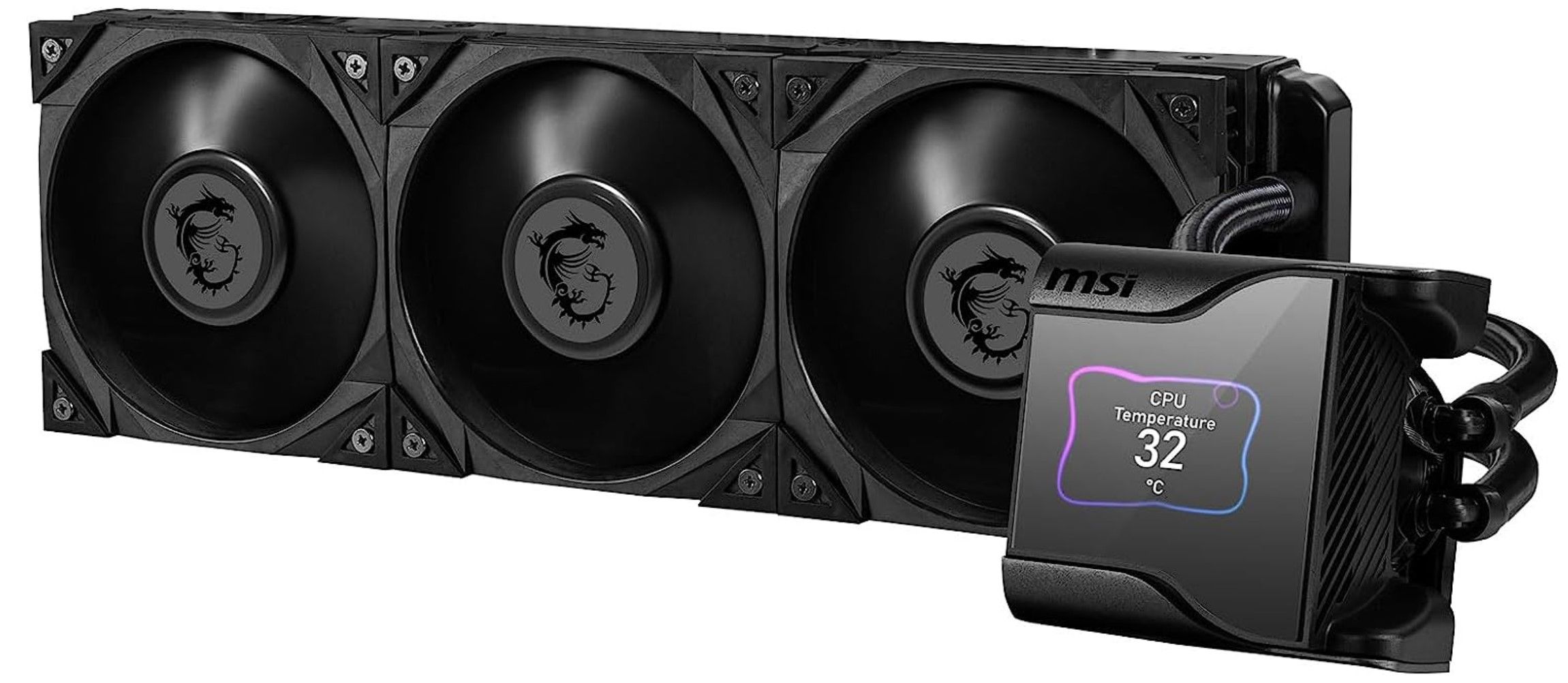
MSI MEG CoreLiquid S360 Cooler
The MSI MEG CoreLiquid S360 Cooler will unlock the overclocking potential of AMD and Intel CPUs, with cooling that far surpasses any conventional fan/heatstink combination. Compatible with the most recent Intel LGA 1700 processors, the CoreLiquid S360 features a 7th generation Asetek pump, a 60 mm VRM fan to cool adjacent components, and 3 Silent Gale P12 fans. A beautiful 2.4-inch IPS display keeps gamers and system builders constantly aware of CPU temps, pump and radiator fan speeds, and much more.
- Brand
- MSI
- Cooling Method
- Liquid
- Integrated Lighting
- No
- Noise Level
- 21.2 dBA
- Fan Speed
- 2000 RPM (variable)
- Attractive and versatile 2.4" LCD screen
- Works with most CPUs and the latest Intel LGA 1700 socket
- Includes VRM fan in water block
- MSI Center is easy to use for novice overlockers
- Similar performance possible with less expensive liquid coolers
- P12 Silent Gale fans lack RGB lighting
Contents of Package
The MSI MEG CoreLiquid S360 ships in a rectangular box with a black and gold color scheme that matches the packaging for the manufacturer's other high-end components.
Inside the retail box are the radiator, 2 motherboard backplates for various CPUs, 3 Silent Gale P12 fans, a cover for the LCD, and a collection of screws, bolts, and washers.
Surprisingly, there was no manual or quick start guide in the box, but there was a bar code on the packaging for downloading documentation.
Installation
To test out the MSI MEG CoreLiquid S360, the build includes an MSI MPG Z590 Gaming Carbon Wi-Fi motherboard with an Intel Core i5 11600K CPU and 48 GB of DDR4 memory. The case used is the MEG Prospect 700R large mid-tower, which is an excellent, albeit costly match for this liquid cooling system. Later on, the Core i5 11600K CPU was overclocked to stress test the MEG CoreLiquid S360.
Once the parts are unpacked, the first part of the installation sequence involves affixing the backplate to the reverse side of the motherboard. The bracket for LGA 1200 CPUs pops into the available holes, waiting for the block to attach on top of it on the other side of a motherboard.
In this closed-loop system, the water block comes attached to the radiator hoses and the radiator itself. After removing the plastic covering on the block, there is some thermal paste already applied, ready to make contact with a CPU. MSI provides standoff screws that connect to the backplate on the other side.
The block itself has a plate on it with screw holes that can accommodate different size sockets. Sitting on the standoff screws, the bottom of the block is pressed on top of the CPU and then secured using bolts. MSI recommends tightening the bolts in a specific order, so buyers will want to refer to the manual. With the large radiator connected to the water block and the LCD screen dangling, it's a bit awkward to position the parts correctly, but the process was straightforward enough.
In this instance, the MSI MEG Prospect 700R case provided numerous possible locations for the CoreLiquid S360 radiator. While the front, rear, and even side panel of the case was an option, the top of a chassis is always a practical spot for a radiator. Installers should think in advance about the best place for this liquid cooler in their rig, but many recent mid and full-tower PC cases are compatible.
If possible, it's much easier to attach the three 120 mm Silent Gale P12 fans with the radiator still outside the case. It's important to consider the orientation of the fans to make sure that air is exhausted in the correct direction for a cooling configuration. Since installers may place the P12s in some unusual places, MSI has included extension cables to ensure that they are in the range of the water block. Also, for cable management purposes, some thought should be given to the orientation of the fan cables that connect to the block.
The radiator was installed easily underneath the topside of the MEG Prospect 700R case, using the included screws and washers. Finally, the water block and LCD connect to the CPU fan and USB headers on motherboards for BIOS and software control of the system. Gamers concerned about the complexity of installing an AIO liquid cooler for the first time should find that working with the MEG CoreLiquid S360 is mostly a frustration-free experience.
Design and Features
Like with most closed-loop water coolers, the 7th generation Asetek pump in the MEG CoreLiquid S360's water block pushes heated liquid near the CPU socket through the hoses to the radiator and its fans where it is cooled, and then the liquid returns to the CPU to repeat the cycle continuously.
The Silent Gale P12 fans in this setup sit just below the radiator at the top of the case. These fans are quite pricey on their own, benefiting from blades that are angled perfectly to optimize airflow. While MSI didn't skimp on the quality of the included fans, the lack of RGB effects is noticeable, especially on a high-end water cooler. It's not so much of an issue if a case already has plenty of RGB cooling fans, but it's hard to see many gamers wanting to install these on a front panel.
The water block itself is quite large, possibly to the point of causing issues in more compact setups. Not so visible is the 60 mm fan inside the water block. Other liquid cooling systems have the unfortunate side effect of blocking airflow across VRMs, memory sockets, and other critical motherboard components which is usually not an issue with conventional air coolers.
The obvious highlight of the MSI MEG CoreLiquid S360 is its 2.4-inch LCD. With some thoughtful planning, the screen can be rotated in the MSI Center app to accommodate the various orientations a buyer can affix the water block to a CPU socket.
MSI Center is required to make the best use of both the display and fan speed settings that automatically adjust according to CPU temperatures. Users can select exactly what information they want to show on the LCD screen with options consisting of CPU temperature, GPU usage, liquid temperature, as well as the water pump and radiator fan speeds. Gamers can also customize a banner or graphic to show on the screen, or they can configure a clock or weather widget.
In the Fan Setting tab, it's possible to select from several preset fan curves including the self-explanatory Silent, Balanced, and Game mode which maximizes the cooling efforts of the MEG CoreLiquid S360. For those users setting up custom fan curves, this is possible by specifying at what temperatures the radiator fan, pump, and water block fan step up their efforts.
For anyone who is nervous about configuring the various cooling elements of a liquid cooler, MSI Center makes it as simple as possible with all the available tweaks accessed on a few screens.
Performance and Cooling
To put the MEG CoreLiquid S360 to the proper test, the 11th-generation Core i5 11600K CPU was overclocked to 5 GHz. With a typical air cooler/heatsink combination, this would normally cause this CPU's temperatures to rise to unsafe levels when under a heavy load. That's where a liquid cooling system is an attractive solution, with the S360 also capable of cooling the latest 13th-generation Intel processors.
Game ZXC ran a series of benchmarks on the MEG CoreLiquid S360 using a combination of AIDA64 Stress CPU, Stress FPU, and Stress Cache tests. The ambient temperature of the room was 20 degrees Celsius and the tests were run for 30 minutes each with Silent, Balanced, and Game modes selected in MSI Center. The AIDA64 FPU stress test, in particular, puts as much load on a processor as any benchmarking program available.
With the MEG CoreLiquid S360 running, the test rig was able to successfully pass each AIDA64 test. Without a great difference in the default fan curve of the Balanced and Game modes, the average CPU temperatures remained in the 70 to 73 degree Celsius range. However, with Silent Fan mode, temperatures did rise to 87 degrees at times, with an average temperature of 81 degrees.
Even the best gaming PCs spend much of their lifetime running idle, waiting for their power to be unleashed. With the Balanced profile active and no demanding applications running, the rig here saw its CPU temperatures hover at 28 degrees Celsius or less, which is more impressive than most air coolers could accomplish.
The MEG CoreLiquid S360 performed well compared to less expensive alternatives like the ARCTIC Liquid Freezer II 360 and similarly to other high-end AIO liquid coolers, such as the EK 360 mm AIO Elite. In most cases, performance differences aren't stark, so brand preferences come into the buying equation along with whether RGB fans are a priority.
MSI's AIO liquid cooler kept CPU temperatures under control without generating an excessive amount of noise. Utilizing hydro-dynamic bearings and anti-vibration fan gaskets, the 3 P12 fans generate anywhere from 20 to 50 decibels of noise, with the latter only experienced in game mode with overclocked CPU temps approaching 80 degrees Celsius and above. Above 30 decibels, the noise becomes more noticeable and higher than what one would expect with most air coolers. The fans are capable of coming to a complete halt in Silent mode, with the default CPU temperature limit of 49 degrees Celsius or less. Outside of intensive game action or testing, the MEG CoreLiquid S360 remained below this threshold, but results will also depend on how insulated a case is.
During the evaluation period, there were very few complaints about the overall operation of the MEG CoreLiquid S360. The MSI Center software was stable and the liquid cooler's monitors were reliable, which is critical when pushing a rig to its limits. Occasionally, after making tweaks in the BIOS, the LCD either failed to load or would become stuck showing certain readings. The only remedy was rebooting the PC, but this was not an issue with normal rebooting or cold boots. If the MEG CoreLiquid S360 is not properly connected to a power supply or USB header, a warning will show on the LCD screen.
Conclusion

MSI MEG CoreLiquid S360 Cooler
The MSI MEG CoreLiquid S360 Cooler will unlock the overclocking potential of AMD and Intel CPUs, with cooling that far surpasses any conventional fan/heatstink combination. Compatible with the most recent Intel LGA 1700 processors, the CoreLiquid S360 features a 7th generation Asetek pump, a 60 mm VRM fan to cool adjacent components, and 3 Silent Gale P12 fans. A beautiful 2.4-inch IPS display keeps gamers and system builders constantly aware of CPU temps, pump and radiator fan speeds, and much more.
- Brand
- MSI
- Cooling Method
- Liquid
- Integrated Lighting
- No
- Noise Level
- 21.2 dBA
- Fan Speed
- 2000 RPM (variable)
- Attractive and versatile 2.4" LCD screen
- Works with most CPUs and the latest Intel LGA 1700 socket
- Includes VRM fan in water block
- MSI Center is easy to use for novice overlockers
- Similar performance possible with less expensive liquid coolers
- P12 Silent Gale fans lack RGB lighting
The MSI MEG CoreLiquid S360 is a premium AIO liquid cooler with a price that results in lofty expectations for its performance. While the MEG CoreLiquid S360 doesn't set groundbreaking marks for cooling, it ranks among the best options when overclocking a wide range of Intel and AMD CPUs.
Installation – which can seem perilous to buyers not accustomed to dealing with radiators – is hard to get wrong, provided that a case has sufficient space. The MEG CoreLiquid S360 ships with parts that are flexible enough to use with most common CPUs and newer motherboards with LGA 1700 sockets. With long fan cables and a display that can be rotated in software, this cooling system can find a welcome home in most rigs.
The 2.4-inch LCD screen is what will garner interest from gamers looking to make their rigs stand out from the crowd. The screen is remarkably customizable, with options to monitor everything happening with the cooling system as well as GPU usage. The MSI Center shines here, with simple and easy-to-navigate menus giving access to practical fan speed modes for idle conditions and serious gaming sessions.
The three 120 mm Silent Gale P12 fans remain reasonably quiet even when CPU temperatures climb close to maximum thresholds. However, MSI opted for an all-black stealth look instead of including RGB lights compatible with their Mystic Light ecosystem. This lack of added flair seems strange when considering the beautiful screen near the fans and the look of MSI's other well-decorated cases and gaming gear.
The 60 mm VRM fan embedded in the water block is another selling point for the MEG CoreLiquid S360. It should appeal to system builders with concerns about liquid coolers blocking airflow to vital motherboard components.
Despite its unlit fans, the MSI MEG CoreLiquid S360 offers an attractive blend of performance and features that make it a standout option in an increasingly crowded field of AIO liquid coolers.
Related Products
If a buyer is looking for an alternative to the MSI MEG CoreLiquid S360 but an LCD screen remains a priority, the Corsair iCUE H150i ELITE LCD XT liquid cooler is a logical option. The 2.1-inch LCD screen on the iCUE H150i ELITE is smaller than the 2.4-inch display on MSI's but is slightly higher resolution. RGB fanatics may flock to Corsair's liquid cooler since it ships with 3 RGB-enabled 120 mm fans, as well as a control box to coordinate the lighting of other fans and strips.
There are, in fact, high-end liquid coolers that retail for a higher price than the MSI MEG CoreLiquid S360. The ASUS ROG Ryujin II 360 RGB is regarded by many industry experts as one of the most powerful closed-looped water cooling systems. The ROG Ryujin II 360 RGB has a supersized 3.5-inch LCD screen and shares the same 7th Generation Asetek water pump as the MEG CoreLiquid S360. Carrying a 6-year warranty, the Asus cooler provides some peace of mind that the system won't start leaking or drying out anytime soon. Unfortunately, gamers will have to use the Armoury Crate software to maximize the potential of the ASUS ROG Ryujin II 360 RGB, which receives regular complaints for its bugs and bloat.
For a more affordable liquid cooling solution, the ARCTIC Liquid Freezer II 360 A-RGB provides performance in the ballpark of the MSI MEG CoreLiquid S360 for considerably less money. This cooler includes a 40 mm VRM fan and a much slimmer water block than its MSI competitor. The three 120 mm fans function using a tremendous amount of static pressure, and the system is available with or without RGB lighting.
$290 | |
$287 | |
$160 |
FAQ
Q: Is liquid cooling better than air CPU coolers?
Liquid cooling is best suited for CPUs that are significantly overclocked. These cooling systems use water as an alternative to air since liquid is a much better conductor of heat. The majority of PC builders will find lower-priced and easier-to-install air CPU coolers a more practical solution.
Q: Why should buyers purchase cooling products with a stock CPU cooler?
The stock CPU fans and heatsinks that ship with many Intel and AMD CPUs are fine for many users. However, if buyers wish to overclock a CPU, the basic stock coolers may not handle the excessive heat that an overworked processor generates.


